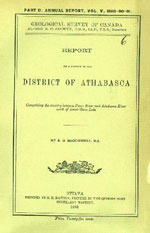Common menu bar links
Institutional links
ARCHIVED - Treaty 8
Archived Content
This archived Web page remains online for reference, research or recordkeeping purposes. This page will not be altered or updated. Web pages that are archived on the Internet are not subject to the Government of Canada Web Standards. As per the Communications Policy of the Government of Canada, you can request alternate formats of this page on the Contact Us page.
Why a Treaty?
Richard G. McConnell’s published final report on his Athabasca survey, 1893
Long before a treaty was signed, scientists from the Geological Survey of Canada -- Richard G. McConnell, in particular -- were very active in the region.
The reports of government geologists led a Senate Committee to conclude that the petroleum reserves in Athabasca’s tar sands would rank "... among the chief assets comprised in the Crown Domain of the Dominion." The geologists had also identified rich deposits of silver, copper, iron, asphaltum and other minerals of economic value which were expected "...to add materially to the public wealth" of Canada.
McConnell’s final report identified two key areas where drilling operations should concentrate: Pelican Rapids and Athabasca Landing. Although exploratory drilling at these locations in 1894 and 1897 produced little oil, by 1915, the bituminous sands were mined as paving material for Edmonton’s streets.
National Library of Canada CA.2.1989-2641

